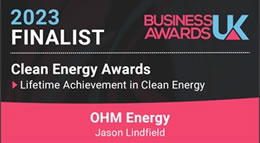Carbon Emissions from New Homes
OHM Energy Sussex
Background
The government has now responded to the Future Building Standards consultation, confirming the compliance measures that are part of the changes to Approved Document L1A of the Building Regulations. Now the standards are clear, we’d like to show how these changes represent an exciting shift towards building zero carbon homes.

A series of approved documents provide guidance on how different aspects of building design and construction can comply with the Building Regulations Approved Document L: Conservation of fuel and power – energy efficiency.
The latest revision accelerates the progress towards zero-carbon housing in the UK. It confirms key changes and sets the ambitious target of an interim 31% reduction in CO2 emissions compared to 2013 standards for homes.
Details focusing on the design of external walls were published in January, and here are the headline changes.
The changes will come into effect from 15 June 2022, with a transition period lasting until June 2023. For transitional arrangements to apply to a building, developers need to:
If neither of these criteria are met, the building will be constructed in line with 2021 Part L standards.
These changes have been described as is a “stepping stone” on the pathway to becoming a net zero society. OHM Energy works closely with developers installing low carbon heating and solar panels on new and existing homes. We can help guide you through these changes to ensure compliance and make the transition as smooth as possible.
Call us on 01323 739474 or email info@ohmenergy.co.uk.
Our Awards and Accolades
We have received numerous awards for decarbonising the community. Do you want help lowering your bills and reducing your carbon footprint?









Subscribe to the OHM newsletter for exclusive energy incentives and offers.
Subscribe to the OHM newsletter for exclusive energy incentives and offers.